 | ||
|
Shishi in Asakusa (spring, 2005) This is an ink and watercolor sketch of a "shishi" on the grounds of the temple compound Sensoji temple in Asakusa, Tokyo. I stood the whole time for this one since I was in the middle of a walk way that leads to a temple, and there was no place to sit. I used both a brush pen and fountain pen, both filled with carbon ink. It was then finished with watercolors from my little portable wooden sketch kit. 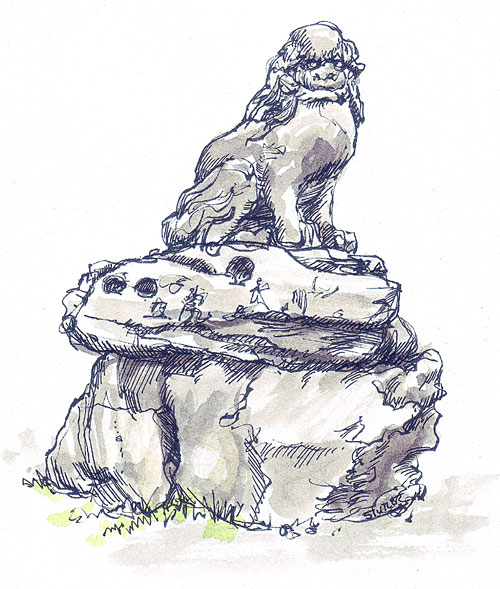 Shishi statues depict mythical beasts that resemble lions. There are always two of these statues guarding both sides of the entrance to Buddhist temples and Shinto shrines. One always has its mouth open and the other has its mouth closed. Looking at this one, it's apparent I drew the one with the closed mouth. It was on the left side of the path guarding one of the many temples in the area. I've drawn shishi statues before, mainly because they are usually very interesting, and they stay perfectly still. While most shishi rest on a pedestal of carved stone blocks, this partcular shishi was resting on a couple of old stones left in their natural shapes, having been carved by nature and the elements over the years. Hokusai drew a shishi every morning in his old age, for good luck. Asakusa is a great place for a sketching day. This soba (noodle) shop was not too far from the temple grounds. It stood on a sunny five way street corner in a very old looking neighborhood. 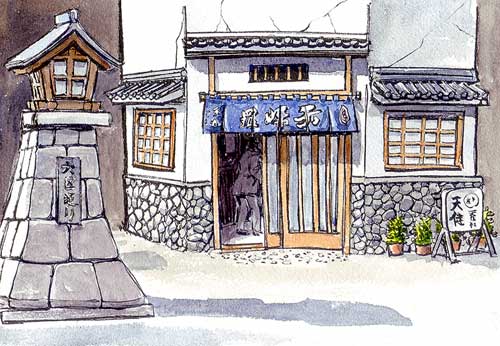 Soba shops can be found everywhere, and are very popular. Thes are very small and fill up with customers very quickly at lunch time. No problem, there is often another soba shop just a few doors down the street. I go for day long walks around Tokyo, and often find that the only eateries to be found in out of the way neighborhoods are soba shops or ramen shops. Some people can eat noodles every day, but I'm not one of them. Back at the mighty Arakawa river, I sat down and sketched yet another yagata-bune. As I've mentioned before I've always wanted to go for a cruise on one of these floating party boats. For now I'll settle for sketching them from the land. The name of this one is the Yamaguchi maru. Maru is the suffix on every boat name I have seen in Japan, and it basically means round, or circle. I have no idea why it is used for boat names. Yamaguchi is a common family name. 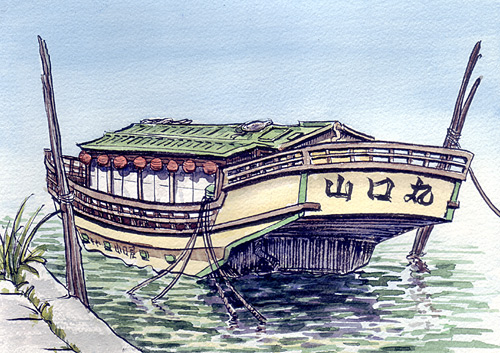 As I sketched this, a man came up and stood in silence behind me for the longest time, which I still find unnerving no matter how many times it has happened to me. Finally he commented that Mr. Yamaguchi would probably be very happy to have this sketch. I wondered if perhaps he was Mr. Yamaguchi himself, and whether or not I should offer this sketch in exchange for a free cruise. I gave up on that idea as the man walked away. I made this next sketch when I was walking though Kiba Park in Tokyo. There is a quiet fenced in section in the park that features all kinds of flowers. Within that area is a secluded traditional rock garden surrounded by a small bamboo fence. In the corner of this rock garden I found this spring surrounded by stones. In the center is a carved stone basin to catch water that comes from a bamboo water outlet. 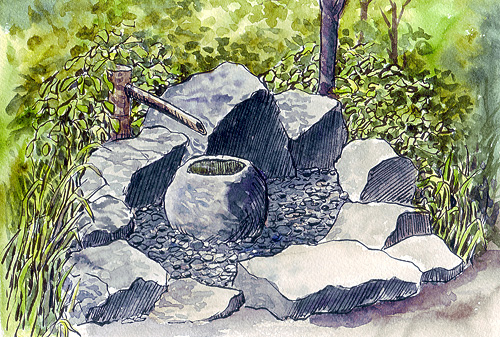 I was moved by the way the light was filtering through the foliage, casting shadows on the rocks. It was such a peaceful scene on a beautiful spring afternoon. As I sketched, a bird landed on the tall rock in the center behind the basin and proceeded to scold me loudly for disturbing the tranquility of his garden. I would have sketched the bird, but the result would have looked contrived. What are the chances of a bird actually sitting in the middle of such a scene? Even though he was there, who would believe it? Anyway, he flew away before I had a chance to reconsider, This was done with carbon ink in a brush pen plus watercolors. This is a sketch of a "sento" or public bath. In the past ten years or so, most neighborhood sentos have been torn down as more new homes are built with their own baths, but there was a time when practically no home had a bath, and sentos flourished. 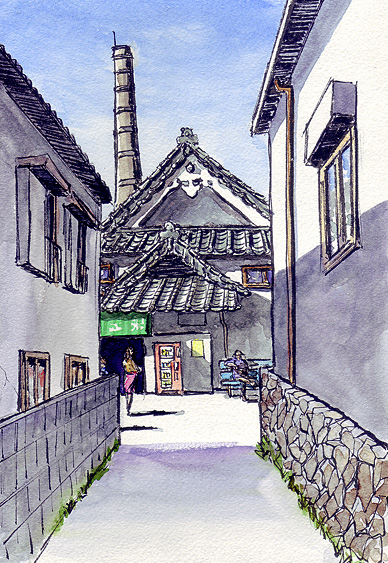 My first apartment in Tokyo had no bath, and I have fond memories of my evening trips to the sento down the street. The tub is big and deep, and some can fit a dozen people or more (and yes, they are segregated by gender, at least in the city). The water is very hot, goes to about the neck when you're sitting, and very relaxing; a great way to wash away stress. You can see people gathering around the entrance at 4:00 in the afternoon, when the sento opens for business. You can recognize a sento by its old architecture resembling some Edo era Japanese castle, plus the tall smoke stack. I found this one in Ichikawa which is just outside of Tokyo in Chiba. It was late afternoon, and the sento had just opened. This was done with a brush pen and carbon ink, and painted with watercolors. |
Next page >> |
 |